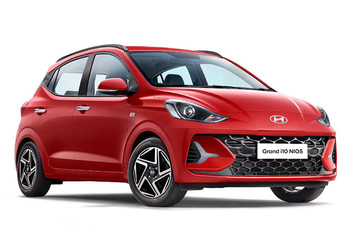BYD Atto 3 vs MG ZS EV vs Hyundai Kona EV: specifications compared
The Atto 3 has the largest battery and the highest ARAI-claimed range among its rivals.
Published On Oct 16, 2022 09:00:00 AM
26,236 Views
Follow us onChinese carmaker BYD recently showcased the Atto 3 electric SUV as the brand's second offering in India after the e6 MPV. The company has already started accepting bookings with deliveries set to commence from January 2023.
The Atto3 is slated to launch sometime in November and is expected to be priced around the Rs 30 lakh mark. For that price, it will see competition from the likes of the MG ZS EV and Hyundai Kona Electric. We compare the newest entrant in the midsize electric SUV space against its rivals to see how it stacks up on paper.
BYD Atto 3 vs ZS EV vs Kona EV: dimensions
| BYD Atto 3 vs rivals: dimensions | |||
|---|---|---|---|
| BYD Atto 3 | MG ZS EV | Hyundai Kona EV | |
| Length | 4,455mm | 4,323mm | 4,180mm |
| Width | 1,875mm | 1,809mm | 1,800mm |
| Height | 1,615mm | 1,649mm | 1,570mm |
| Wheelbase | 2,720mm | 2,585mm | 2,600mm |
| Boot capacity | 440-litres | 470-litres | 332-litres |
| Ground clearance | 175mm | 177mm | 170mm |
| Wheel size | 18-inch | 17-inch | 17-inch |
The Atto 3 is the largest among its rivals, and by a fair margin. At 4,455mm in length, the Atto 3 is 132mm longer than the ZS EV and a significant 275mm longer than the Kona EV. Its wheelbase is also 135mm and 120mm longer than the ZS EV and Kona EV, respectively, with the Atto 3 also being the widest of the lot. The only dimension where a rival has an edge is in its height – the ZS EV being 34mm taller. The Kona EV, meanwhile, is the smallest in this company.
In terms of boot space, however, the ZS EV's is the largest, followed by the Atto 3 and the Kona EV. All three SUVs are very closely matched in terms of ground clearance, set apart by 7mm only. The ZS EV has the highest ground clearance while the Kona EV has the least. As for wheel size, the Atto 3 rides on larger 18-inch rims as compared to its rival’s 17-inch wheels.
BYD Atto 3 vs ZS EV vs Kona EV: powertrain and range
| BYD Atto 3 vs rivals: powertrain and range | |||
|---|---|---|---|
| BYD Atto 3 | MG ZS EV | Hyundai Kona EV | |
| Battery Capacity | 60.48kWh | 50.3kWh | 39.2kWh |
| Electric Motor | Permanent magnet synchronous motor | Permanent magnet synchronous motor | Permanent magnet synchronous motor |
| Power | 204hp | 176hp | 136hp |
| Torque | 310Nm | 280Nm | 395Nm |
| Range (ARAI claimed) | 521km | 461km (ICAT) | 452km |
All three SUVs are powered by a front axle-mounted permanent magnet synchronous motor, although it is the Atto 3 that has the largest battery pack at 60.48kWh – 10.18kWh larger than the ZS EV and 21.28kWh larger than the Kona EV. The Atto 3 is also the most powerful in this company, producing 28hp more than the ZS EV and 68hp more than the Kona EV, however, the Kona EV has the highest torque output among its rivals – 85Nm more than the Atto 3 and 115Nm more ZS EV.
The Atto 3's largest battery pack helps it boast of the highest claimed range of 521km, which is 60km and 69km more than the ZS EV and Kona Electric, respectively. Do note that the claimed range figures of the Atto 3 and Kona EV are ARAI-certified, but the ZS EV has an ICAT certification.
BYD Atto 3 vs ZS EV vs Kona EV: charging
| BYD Atto 3 vs rivals: charging | |||
|---|---|---|---|
| BYD Atto 3 | MG ZS EV | Hyundai Kona EV | |
| AC slow charging | NA | 18-19hrs to 100% (15 A socket) | 19hrs to 100% (2.8kW socket) |
| AC fast charging | About 10hrs to 100% (7kW) | 8-9hrs to 100% (7.4kW) | 6hrs 10mins to 100% (7.2kW) |
| DC fast charging | 50 mins to 80% (80kW) | 1 hr to 80% (50kW) | 57mins to 80% (50kW) |
As for charging, the ZS EV and Kona EV can both be plugged into a regular three-pin domestic socket, although BYD hasn’t stated the same for the Atto 3. However, using an AC fast charger, the Atto 3 and ZS EV have very comparable charging times. The former does take about an hour more, but it also has a larger battery pack. Meanwhile, the Kona EV takes the least time to top up to 100 percent, but that's due to it having the smallest battery pack of the lot.
Using a DC fast charger, the Atto 3, despite having the largest battery, takes the least time to top up to 80 percent, although it uses a more powerful 80kW charger for that. Meanwhile, using a 50kW DC fast charger, the Kona EV charges just three minutes faster than the ZS EV to 80 percent, despite the latter having a significantly larger battery.
Also See:
Copyright (c) Autocar India. All rights reserved.



















Comments
Member Login
Personal Details
Nagakiran KR - 923 days ago
DC fast charging speed comparison is incorrect I feel. During a comparison an exactly similar source of power should be employed. In this case why not use 80 or 100kw as input if you don't want to downplay Atto3? Confusing the reader by showing lower charge times with a higher capacity charger is not advisable IMHO. If the idea was to portray max permissible charge speed then they all should use highest possible charger capacity let them draw whatever they are capable.